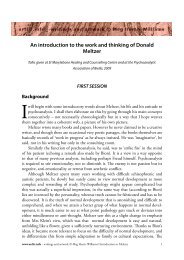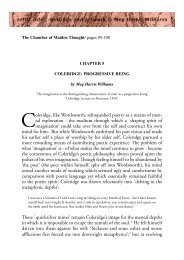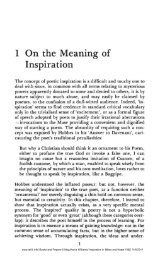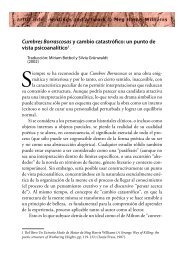Genesis of the 'aesthetic conflict' by Meg Harris Williams ... - Artlit
Genesis of the 'aesthetic conflict' by Meg Harris Williams ... - Artlit
Genesis of the 'aesthetic conflict' by Meg Harris Williams ... - Artlit
Create successful ePaper yourself
Turn your PDF publications into a flip-book with our unique Google optimized e-Paper software.
29/01/2012While Bion’s <strong>the</strong>ory <strong>of</strong> thinking proposed a view <strong>of</strong> mo<strong>the</strong>r-ba<strong>by</strong> communicationbased on ‘speculative imagination’ (as he called it), infant observation as a disciplinewas an art-science like psychoanalysis itself. The analogy with <strong>the</strong> ‘aes<strong>the</strong>ticcriticism’ <strong>of</strong> poetry and its focus on <strong>the</strong> minutiae <strong>of</strong> poetic diction in <strong>the</strong> widerprocess <strong>of</strong> symbol-formation became more understandable and mutually enhancing.It followed naturally ‘as <strong>the</strong> leaves to a tree’ (to cite Keats on poetry) that <strong>the</strong>reshould be a complementary inquiry into <strong>the</strong> nature <strong>of</strong> psychoanalysis as an artform in itself (see The Aes<strong>the</strong>tic Development, 2010). Again this was not a newsuggestion (it is in both early Meltzer and Bion), but <strong>the</strong> link with ano<strong>the</strong>r verbalart form gave it shape and substance.Finally, to return to Meltzer’s aes<strong>the</strong>tic ‘family tree’, what completed <strong>the</strong> picture<strong>of</strong> an organic evolution was <strong>the</strong> clinical work he and o<strong>the</strong>rs did with autisticchildren, whose frequently artistic sensitivity led <strong>the</strong>m to recoil from <strong>the</strong> impact<strong>of</strong> <strong>the</strong> aes<strong>the</strong>tic object, as summarised at <strong>the</strong> end <strong>of</strong> Studies in Extended Metapsychology(p. 207). This refined <strong>the</strong> picture <strong>of</strong> <strong>the</strong> container-contained within<strong>the</strong> psychoanalytic transference, making it clear that it was <strong>the</strong> ‘fitting toge<strong>the</strong>r’<strong>of</strong> <strong>the</strong> analyst’s attention and <strong>the</strong> patient’s co-operativeness, that constituted <strong>the</strong>container and made <strong>the</strong> psychoanalytic process itself into <strong>the</strong> aes<strong>the</strong>tic object. Theanalyst who, like <strong>the</strong> poet, <strong>the</strong> artistic literary critic, or <strong>the</strong> ba<strong>by</strong>-observer, can be‘divested <strong>of</strong> <strong>the</strong> expectation <strong>of</strong> knowing’, is in a position to apprehend how <strong>the</strong>process <strong>of</strong> coming-to-knowledge is itself an aes<strong>the</strong>tic experience. It is governed <strong>by</strong>what Bion calls ‘O’, <strong>the</strong> mystery <strong>of</strong> an object which lies beyond and detached from<strong>the</strong> mind <strong>of</strong> ei<strong>the</strong>r patient or analyst, reader or poet. Meltzer calls it a ‘conversationbetween internal objects’.These paths to knowledge dovetailed to produce <strong>the</strong> concept ‘aes<strong>the</strong>tic conflict’.So it is not <strong>the</strong> word – <strong>the</strong> term ‘aes<strong>the</strong>tic conflict’ – that is <strong>the</strong> new idea; it is itsnew life in <strong>the</strong> context <strong>of</strong> clinical psychoanalysis. The idea takes root and changes<strong>the</strong> perspective <strong>of</strong> <strong>the</strong> entire operation. Meltzer called it ‘<strong>the</strong> new psychoanalysis’.www.harris-meltzer-trust.org.uk/ papers © <strong>the</strong> author 5










